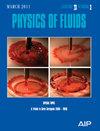揭示通过剪切凝聚气泡增强两相沸腾传热的基本物理学原理
IF 4.3
2区 工程技术
Q1 MECHANICS
引用次数: 0
摘要
即将到来的能源短缺问题促使人们研究开发各种冷却应用所必需的高能效两相热交换器。这项研究以池沸腾原理为基础,而池沸腾对各种热交换器的有效传热至关重要。众所周知,热交换器中存在的一个问题是气泡凝聚导致的受热表面干涸现象。为解决这一不良问题,本研究采用了一种创新技术,即通过液体喷射撞击加热表面来剪切气泡。为了研究这种池沸腾现象所涉及的基本物理原理,我们分析了气泡动力学参数,如偏离频率、气泡直径、冷点(气泡底部)温度和蒸汽体积分数。结果表明,在射流剪切效应的作用下,壁面过热度越高,传热速率最大可提高 25%。研究还突出表明,液体射流提高了蒸汽体积分数,表明蒸汽生成量增加,特别是在壁面过热度升高时,蒸汽体积分数提高了 27%。在剪切效应的作用下,还观察到了早起的缩颈效应,这导致形成的气泡较小,离去频率较高。这项研究为通过气泡剪切增强两相传热的基础物理学提供了一个基准,为两相热交换器设计中的能量守恒,尤其是在池沸腾的背景下,提供了很有前景的见解。本文章由计算机程序翻译,如有差异,请以英文原文为准。
Unveiling the underlying physics of two-phase boiling heat transfer enhancement through shearing of coalescing bubbles
The upcoming energy scarcity problem has driven research toward developing energy-efficient two-phase heat exchangers essential for various cooling applications. This research is rooted in the principles of pool boiling, essential for effective heat transfer in various heat exchangers. A well-known reported problem in heat exchangers is the dry-out phenomena of heated surfaces due to bubble coalescence. To tackle this undesirable problem, an innovative technique has been introduced in this study, which involves the shearing of bubbles through liquid jet impingement over the heated surface. The study has been carried out in a two-dimensional domain numerically, in the wall superheat range of 9–16 K. To study the underlying physics involved in this pool boiling phenomenon, the bubble dynamics parameters such as departure frequency, bubble diameter, cold spot (bubble base) temperature, and vapor volume fraction have been analyzed. The results show that with the jet shearing effect, a maximum enhancement of 25% in heat transfer rate is observed at higher wall superheat. The investigation also highlights that the liquid jet enhances vapor volume fraction, indicating enhanced steam generation, particularly an enhancement of 27% observed at elevated wall superheat. An early onset necking effect is also observed with the shearing effect, which leads to the formation of smaller bubbles with higher departure frequencies. This study is a benchmark to the fundamental physics of enhancing two-phase heat transfer through bubble shearing, offering promising insights for energy conservation in two-phase heat exchanger design, particularly within the context of pool boiling.
求助全文
通过发布文献求助,成功后即可免费获取论文全文。
去求助
来源期刊

Physics of Fluids
物理-力学
CiteScore
6.50
自引率
41.30%
发文量
2063
审稿时长
2.6 months
期刊介绍:
Physics of Fluids (PoF) is a preeminent journal devoted to publishing original theoretical, computational, and experimental contributions to the understanding of the dynamics of gases, liquids, and complex or multiphase fluids. Topics published in PoF are diverse and reflect the most important subjects in fluid dynamics, including, but not limited to:
-Acoustics
-Aerospace and aeronautical flow
-Astrophysical flow
-Biofluid mechanics
-Cavitation and cavitating flows
-Combustion flows
-Complex fluids
-Compressible flow
-Computational fluid dynamics
-Contact lines
-Continuum mechanics
-Convection
-Cryogenic flow
-Droplets
-Electrical and magnetic effects in fluid flow
-Foam, bubble, and film mechanics
-Flow control
-Flow instability and transition
-Flow orientation and anisotropy
-Flows with other transport phenomena
-Flows with complex boundary conditions
-Flow visualization
-Fluid mechanics
-Fluid physical properties
-Fluid–structure interactions
-Free surface flows
-Geophysical flow
-Interfacial flow
-Knudsen flow
-Laminar flow
-Liquid crystals
-Mathematics of fluids
-Micro- and nanofluid mechanics
-Mixing
-Molecular theory
-Nanofluidics
-Particulate, multiphase, and granular flow
-Processing flows
-Relativistic fluid mechanics
-Rotating flows
-Shock wave phenomena
-Soft matter
-Stratified flows
-Supercritical fluids
-Superfluidity
-Thermodynamics of flow systems
-Transonic flow
-Turbulent flow
-Viscous and non-Newtonian flow
-Viscoelasticity
-Vortex dynamics
-Waves
 求助内容:
求助内容: 应助结果提醒方式:
应助结果提醒方式:


